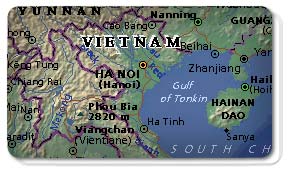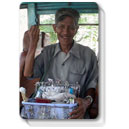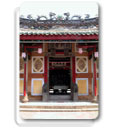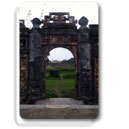A Next Generation's Vietnam
 | Map of where we are. |
Before landing in Saigon, Vietnam was a hazy concept, a jumble of Hollywood movies, US-centric historical accounts, grainy news clips and brief snippets of stories from relatives and their friends. Vibrant images have now replaced the haze. One month spent traveling from South to North has brought the conflict, the country, and the Vietnamese into much clearer focus.
 | Click to Enlarge. |
Walking through the War Remnants Museum in Ho Chi Minh City (Saigon) was a humbling education for two children of Vietnam era vets. It must be similar to how young German visitors feel at the Holocaust Museum in Washington, DC. The Remnants Museum displays the tools of war and visually depicts the destruction inflicted on Vietnam during what the Vietnamese call the 'War of Foreign Aggression' and what we in America call the 'Vietnam War.'
Busloads of Vietnamese children were also receiving an education on the War. Although we could not understand the Vietnamese being shouted by tour leaders through their megaphones, we could tell what was being said. It showed in the wide eyes of the silent children. If anyone had inquired where we were from at that moment, I would have responded Canada. Luckily no one spoke to us.
 | Click to Enlarge. |
An entire room was dedicated to Agent Orange and other chemicals sprayed over the forests of Vietnam. 72 million liters of dioxins were let loose on the country. In Ca Mau province, 60% of the mangrove forests were destroyed. Even more chilling than the environmental destruction was the personal suffering. Picture upon blown up picture of chemical burns and deformations lined the wall. Below the massive pictures were jars of formaldehyde displaying babies with disfigurements too disturbing to recount.
 | Click to Enlarge. |
The second hall we entered focused on bombs dropped by American planes over Vietnam. Curtis LeMay, an American commander, was quoted as saying, "We will bomb them back to the Stone Age". We, the United States of America, came close, dropping over 7.85 million tons of bombs on the country. Seismic bombs, which destroyed everything within 100 meters (300 feet) and violently shook the earth within a 3.2km (2 miles) diameter were displayed alongside frag bombs, oxygen sucking bombs, mines, grenades and many other bombs of mass destruction. Above the physical remnants of the equipment were pictures of the damage wreaked by the bombs. Women, the elderly, children and men were missing limbs and other parts of their bodies. Bomb fragments were imbedded in their skin. Or, they were on their knees in despair next to dead family members in completely annihilated villages.
 | Click to Enlarge. |
Another room exhibited the brutality of US troops. The Massacre at My Lai, Son My in Vietnamese, was recounted to visitors. An entire village of 504 people including 182 women 173 children and 60 elderly men were executed. Life-size pictures of dead women and children lined the walls. Between the women and children were pictures of US GI's holding up trophies of decapitated heads, torturing farmers and committing other atrocities.
The museum was definitely biased. No accounts were made of atrocities committed by the North Vietnamese. There were no photos of Viet Minh torturing US servicemen or of the suffering inflicted on southerners that fought alongside Americans. The final room on the tour was however dedicated to recounting the protests against American involvement that occurred in the US and around the world. Having heard the American side of the story, visiting the museum was a powerful foundation to understanding the Vietnamese side.
My father was an intelligence officer during the war, Will's was in the Navy on a minesweeper. Our uncles and parents' friends also fought here. Through email, Will's uncle recounted briefly some of the places he was stationed as a Marine. They were places we had stopped on our travels. My Aunt emailed how strange it was that we were here vacationing. It seemed completely odd to her that we could travel safely when she could vividly recall friends returning home from Vietnam in body bags.
 | Click to Enlarge. |
In the south of Vietnam, the older generation seemed to want to connect with us. As we traveled, people recounted their stories. In the Mekong, one elderly gentleman, Mr. Ky, approached us on a local bus. He was selling trinkets. His English was quite good. He picked it up in Wichita Falls, Kansas, while learning how to service US aircraft. He explained to us that he had fought for the South. It was very difficult, but he and his family had done okay when the North Vietnamese came. Luckily they had some land and could grow vegetables and fruit. He had survived and now had nine grandchildren. As a final gesture of friendship, he gave us a present. It was an ear cleaner made by his grandchildren of duck feathers from his farm.
 | Click to Enlarge. |
In Hoi An, one of the few cities that escaped U.S. and French bombing, we rode bicycles out to a beautiful white sand beach on the China Sea. The owner of the café we stopped to have lunch at asked where we were from. His father and brothers had also fought alongside US troops. They had tried to escape by boat to Hong Kong when the war was over, but they were sent home. His family had suffered a great deal he explained. Now though, they were fine he said with a smile. His children were doing well and so was his business, especially from the increase of tourism.
 | Click to Enlarge. |
We spent one day in Hue, the former capital of Vietnam. Hue was not as lucky as Hoi An. Will and I visited the Imperial City, Vietnams equivalent of Beijing's Forbidden Palace. It was in ruins, a victim of U.S. and French bombing. The effects could still be easily seen. Buildings were now only shells. Mortar scars pocked national treasures of cement and bronze. The palaces were being meticulously rebuilt though, with funding provided by the United Nations.
 | Click to Enlarge. |
In the north people did not bring up the war as much. One night however, in a hotel in the northwest mountains, Will struck up a conversation with a young tour guide. He was very interested to know why we fought in Vietnam. With a degree in international affairs, I tried to explain the fear of communism that coursed through the veins of America in the 1950's and 60's. He pushed further, "Ho Chi Minh was first a nationalist, like George Washington," he said. "We understand that now," I responded.
Will wanted to know how the Vietnamese could be so tolerant and friendly to Americans when the war ended just over 25 years ago. The tour guide responded in one of the many clichés he had picked up from his charges, "let bygones be bygones." As Vietnam grows they must leave the past behind and look to the future, he further explained.
 | Click to Enlarge. |
The scenery in Vietnam has been truly magnificent: mangroves and rice paddies of the Mekong Delta, the beautiful beaches of the Central Coast and the mountains of the Northwest. Even more amazing however is how the people have welcomed us with open arms.
 | Click to Enlarge. |
The images of the country we will remember will be beauty and friendliness, but they will also include the man on the beach in Nha Trang. He was in late twenties, around our age. He had no arms and no legs, an obvious victim of what we can know identify as chemical deformation. He was slowly negotiating the sidewalk with a basket around his neck. The money we gave him only provided the slightest of salve to the guilt we felt at what our country, the most powerful in the world, had let loose on Vietnam, one of the poorest.
 | Click to Enlarge. |
While eating breakfast in the lobby of our hotel in Hanoi, a story about Vietnam was being broadcast on CNN. A vague sense of discomfort came over me. The waiter, the only other person in the room, asked if they were talking about Vietnam War. I responded affirmatively and tried to explain what the story was about. Sensing my discomfort he turned the channel to MTV.
MKS
|
